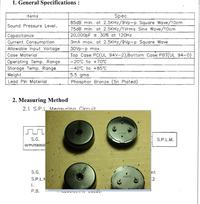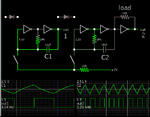pclaptop
Newbie level 3

I'm picking any engineer/small~circuit~design brain for some help!
I want to create two panels(with two separate pcb's) set 3-4 feet apart, that house 10 piezoelectric transducers each that will act as an intrusion deterrent when an alarm condition exists.
These transducers operate at 2.5khz sine or square wave but need a signal generator circuit to supply that waveform to operate. I would like to just apply 12vdc to the 10 piezo's but I think that would create "fried chicken"!
Basically I have a 12vdc battery source that is solar charged(re-charged) at a location where there is no electricity.
I believe all I need is a 555/556 timer circuit with an open collector xsistor(??) to handle the output, but that's as far as my design knowledge goes. Attached you will see a spec sheet for the transducers and a physical picture of the devices themselves. I got a deal on 90 of them.

Also, this circuit I found Googling but I don't know . . .
1) if it will handle 10 of the Piezo's and
2) I want create a very offensive warbling at 2.5khz (hence the 556 timer, one 555 to set at 2.5khz and the other to pulse?) to create a delay or offset the second panel frequency.
http://www.electronicecircuits.com/electronic-circuits/555-variable-frequency-square-wave-generator
Any thoughts suggestions designs ideas pointers?
thanks in advance, chris
I want to create two panels(with two separate pcb's) set 3-4 feet apart, that house 10 piezoelectric transducers each that will act as an intrusion deterrent when an alarm condition exists.
These transducers operate at 2.5khz sine or square wave but need a signal generator circuit to supply that waveform to operate. I would like to just apply 12vdc to the 10 piezo's but I think that would create "fried chicken"!
Basically I have a 12vdc battery source that is solar charged(re-charged) at a location where there is no electricity.
I believe all I need is a 555/556 timer circuit with an open collector xsistor(??) to handle the output, but that's as far as my design knowledge goes. Attached you will see a spec sheet for the transducers and a physical picture of the devices themselves. I got a deal on 90 of them.

Also, this circuit I found Googling but I don't know . . .
1) if it will handle 10 of the Piezo's and
2) I want create a very offensive warbling at 2.5khz (hence the 556 timer, one 555 to set at 2.5khz and the other to pulse?) to create a delay or offset the second panel frequency.
http://www.electronicecircuits.com/electronic-circuits/555-variable-frequency-square-wave-generator
Any thoughts suggestions designs ideas pointers?
thanks in advance, chris

